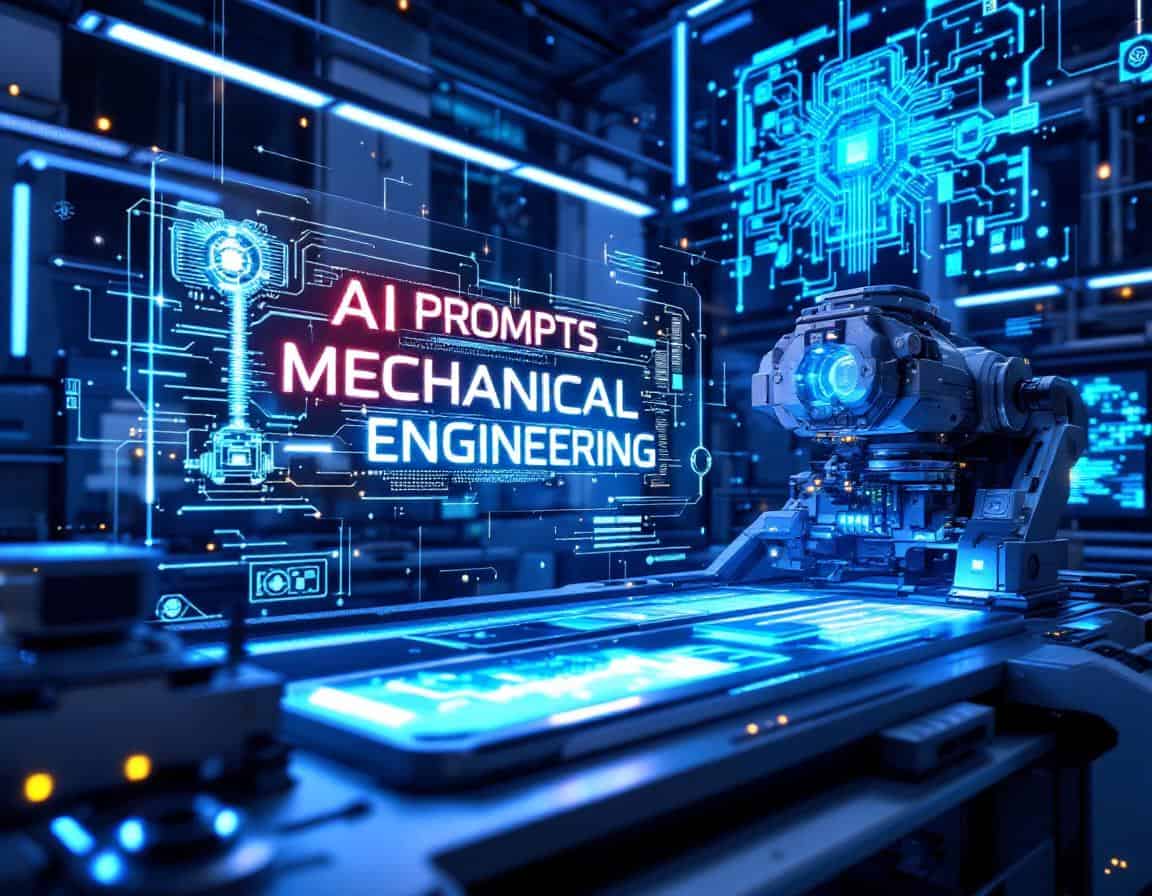
تعمل أدوات الذكاء الاصطناعي عبر الإنترنت على إحداث تحول سريع في الهندسة الميكانيكية من خلال زيادة القدرات البشرية في التصميم والتحليل, التصنيعوالصيانة. يمكن لأنظمة الذكاء الاصطناعي هذه معالجة كميات هائلة من البيانات، وتحديد الأنماط المعقدة، وتوليد حلول جديدة أسرع بكثير من الطرق التقليدية. على سبيل المثال، يمكن أن يساعدك الذكاء الاصطناعي في تحسين التصاميم من حيث الأداء وقابلية التصنيع، وتسريع عمليات المحاكاة المعقدة، والتنبؤ بخصائص المواد، وأتمتة مجموعة واسعة من المهام التحليلية.
The prompts provided below will for example help on generative design, accelerate simulations (FEA/CFD), help on predictive maintenance where AI analyzes sensor data from machinery to forecast potential failures, enabling proactive servicing and minimizing downtime, help on material selection and much more.
- هذه الصفحة خاصة بنطاق واحد. إذا لزم الأمر، يمكنك الحصول على إمكانيات بحث كاملة حسب جميع المجالات وجميع المعايير في > دليل موجهات الذكاء الاصطناعي <، مخصص لـ تصميم المنتج و ابتكار.
- نظرًا لموارد الخادم والوقت، فإن المطالبات نفسها محجوزة للأعضاء المسجلين فقط، ولا تظهر أدناه إذا لم تكن مسجلاً. يمكنك التسجيل، 100% مجاناً:
- تحسين التصميم التجريبي
- الهندسة الميكانيكية
موجه الذكاء الاصطناعي إلى Experimental Plan Critique and Improvement Suggestions
- Design Analysis, تقييم التصميم, تحسين التصميم, تحسين العمليات, ضمان الجودة, مراقبة الجودة, التحليل الإحصائي, تصديق
This prompt asks the AI to analyze a provided experimental design in mechanical engineering, identifying weaknesses and proposing detailed improvements to enhance validity, reliability, and efficiency. The user inputs the experimental plan description and key variables.
المخرجات:
- النص
- لا يتطلب إنترنت مباشر
- Fields: {experimental_plan} {key_variables}
- Best for: Best for optimizing experimental setups to yield more reliable and valid results
- مقترح المنحة والمساعدة في الكتابة العلمية
- الهندسة الميكانيكية
موجه الذكاء الاصطناعي إلى Grant Proposal Significance Section Draft
- التصنيع المضاف, التصميم من أجل التصنيع الإضافي (DfAM), ابتكار, الهندسة الميكانيكية, تطوير المنتجات, النماذج الأولية, البحث والتطوير, ممارسات الاستدامة, القيمة المقترحة
Drafts the Significance and Innovation sections for a mechanical engineering grant proposal highlighting the project’s novelty research gap addressed and potential impact. This prompt helps engineers articulate the core value of their proposed work. The output is a markdown formatted text.
المخرجات:
- تخفيض السعر
- لا يتطلب إنترنت مباشر
- Fields: {project_title} {research_problem_statement} {proposed_solution_summary} {key_innovative_aspects_list_csv}
- Best for: Assisting mechanical engineers in drafting compelling Significance and Innovation sections for grant proposals ensuring clear articulation of research value and novelty.
- تحسين التصميم التجريبي
- الهندسة الميكانيكية
موجه الذكاء الاصطناعي إلى Optimal Experimental Design Generator
- التصميم من أجل التصنيع الإضافي (DfAM), التصميم من أجل التصنيع (DfM), الهندسة الميكانيكية, تحسين العمليات, ضمان الجودة, مراقبة الجودة, البحث والتطوير, التحليل الإحصائي
This prompt instructs the AI to design an optimal experiment to investigate specified mechanical engineering parameters. The user provides the research question, variables to test, and constraints. The AI returns a full experimental plan with control groups, sample sizes, and measurement strategies.
المخرجات:
- تخفيض السعر
- لا يتطلب إنترنت مباشر
- Fields: {research_question} {variables} {constraints}
- Best for: Best for generating comprehensive, statistically sound mechanical engineering experiments
- مقترح المنحة والمساعدة في الكتابة العلمية
- الهندسة الميكانيكية
موجه الذكاء الاصطناعي إلى Technical Report Abstract Generator
- التحسين المستمر, التصميم من أجل التصنيع الإضافي (DfAM), الهندسة الميكانيكية, المنهجية, تحسين العمليات, إدارة المشاريع, إدارة الجودة, البحث والتطوير, ممارسات الاستدامة
Generates a concise and informative abstract for a technical report based on key sections of the report. This prompt helps engineers quickly summarize their work for wider dissemination. The output is a plain text abstract.
المخرجات:
- النص
- لا يتطلب إنترنت مباشر
- Fields: {report_title} {project_objectives_summary} {methodology_used_summary} {key_results_and_conclusions_summary}
- Best for: Generating concise and well-structured abstracts for technical reports helping mechanical engineers efficiently summarize project objectives methods results and conclusions.
- تحسين التصميم التجريبي
- الهندسة الميكانيكية
موجه الذكاء الاصطناعي إلى Statistical Power Analysis for Experiments
- التصميم لسداسية سيجما (DfSS), تحسين العمليات, تحسين العمليات, ضمان الجودة, مراقبة الجودة, التحليل الإحصائي, التحكم في العمليات الإحصائية (SPC), الاختبارات الإحصائية, تصديق
This prompt requests the AI to perform a statistical power analysis for a mechanical engineering experiment based on input parameters such as effect size, sample size, and significance level. It helps determine if the experiment is sufficiently powered.
المخرجات:
- النص
- لا يتطلب إنترنت مباشر
- Fields: {effect_size} {sample_size} {significance_level}
- Best for: Best for validating experimental designs through power calculations
- مقترح المنحة والمساعدة في الكتابة العلمية
- الهندسة الميكانيكية
موجه الذكاء الاصطناعي إلى Research Paper Methodology Critique
- التصميم من أجل التصنيع الإضافي (DfAM), الهندسة الميكانيكية, المنهجية, تحسين العمليات, ضمان الجودة, مراقبة الجودة, البحث والتطوير, التحليل الإحصائي, تصديق
Reviews and suggests improvements for the methodology section of a mechanical engineering research paper focusing on clarity completeness justification and appropriateness of the methods used. This prompt aids in enhancing the rigor and reproducibility of research. The output is a markdown formatted critique.
المخرجات:
- تخفيض السعر
- لا يتطلب إنترنت مباشر
- Fields: {current_methodology_section_text} {research_objectives_text} {key_equipment_or_software_used_list_csv}
- Best for: Providing detailed constructive critiques of research paper methodology sections helping mechanical engineers improve the clarity rigor and reproducibility of their work.
- تحسين التصميم التجريبي
- الهندسة الميكانيكية
موجه الذكاء الاصطناعي إلى منشئ قائمة مراجعة التحقق من صحة البيانات التجريبية
- الهندسة الميكانيكية, ضمان الجودة, مراقبة الجودة, إدارة الجودة, التحليل الإحصائي, طرق الاختبار, تصديق, التحقق
تطلب هذه المطالبة من الذكاء الاصطناعي إنشاء قائمة مراجعة مفصلة للتحقق من جودة وسلامة البيانات التجريبية للهندسة الميكانيكية التجريبية بناءً على وصف التجربة ونوع البيانات التي قدمها المستخدم.
المخرجات:
- تخفيض السعر
- لا يتطلب إنترنت مباشر
- الحقول: {وصف_التجربة} {نوع_البيانات}
- الأفضل لـ الأفضل لضمان جمع البيانات التجريبية عالية الجودة والموثوقة وتحليلها
- مقترح المنحة والمساعدة في الكتابة العلمية
- الهندسة الميكانيكية
موجه الذكاء الاصطناعي إلى هيكل مراجعة الأدبيات للمقدمة
- التصنيع المضاف, التحسين المستمر, التصميم من أجل التصنيع الإضافي (DfAM), ابتكار, الهندسة الميكانيكية, إدارة الجودة, ممارسات الاستدامة
يساعد في هيكلة مراجعة الأدبيات لقسم مقدمة الورقة البحثية من خلال تحديد الموضوعات الرئيسية من الملخصات المقدمة واقتراح تدفق منطقي لتحديد الفجوة البحثية لموضوع الهندسة الميكانيكية. المخرجات عبارة عن مخطط تفصيلي وإرشادات سردية.
المخرجات:
- تخفيض السعر
- لا يتطلب إنترنت مباشر
- الحقول: {عنوان_موضوع_البحث} {قائمة_بالملخصات_المفاتيح_المفاتيح_أو_نص_الصحف} {البحث_الرئيسي_الفجوة_الرئيسية_أو_السؤال}
- الأفضل لـ مساعدة المهندسين الميكانيكيين على هيكلة مراجعة الأدبيات في مقدمات الأوراق البحثية من خلال تنظيم المعلومات من الملخصات الموجودة بشكل موضوعي ومنطقي يؤدي إلى فجوة البحث.
- النمذجة التنبؤية
- الهندسة الميكانيكية
موجه الذكاء الاصطناعي إلى منشئ نموذج التنبؤ بخصائص المواد
- التعلّم الآلي, المواد, الهندسة الميكانيكية, الخواص الميكانيكية, خوارزميات الصيانة التنبؤية, مراقبة الجودة, إدارة الجودة, التحليل الإحصائي
يرشد هذا الموجه الذكاء الاصطناعي إلى بناء نموذج تنبؤي لخصائص المواد الميكانيكية استنادًا إلى بيانات الاختبار التاريخية التي يقدمها المستخدم بتنسيق CSV. وهو يتضمن خطوات اختيار النموذج والتدريب والتحقق من صحة النموذج.
المخرجات:
- بايثون
- لا يتطلب إنترنت مباشر
- الحقول: {csv_material_data} {الخاصية_المستهدفة}
- الأفضل لـ الأفضل لإنشاء نماذج تعتمد على البيانات للتنبؤ بسلوك المواد
- النمذجة التنبؤية
- الهندسة الميكانيكية
موجه الذكاء الاصطناعي إلى أداة التنبؤ بأداء النظام
- تقييم الأثر البيئي, التقنيات البيئية, التعلّم الآلي, خوارزميات الصيانة التنبؤية, إدارة الجودة, التحليل الإحصائي, التحكم في العمليات الإحصائية (SPC), تصميم النظام
تطلب هذه المطالبة من الذكاء الاصطناعي التنبؤ بالأداء المستقبلي لنظام ميكانيكي بناءً على البيانات التشغيلية التاريخية والعوامل البيئية المقدمة بتنسيق JSON. يقوم الذكاء الاصطناعي بإخراج تنبؤ سلسلة زمنية مع فترات ثقة.
المخرجات:
- JSON
- لا يتطلب إنترنت مباشر
- الحقول: {historical_data_data_json} {العوامل_البيئية_json}
- الأفضل لـ الأفضل لتوقع سلوك النظام الميكانيكي في ظل ظروف مختلفة



























هل نفترض أن الذكاء الاصطناعي قادر دائمًا على توليد أفضل المطالبات في الهندسة الميكانيكية؟ كيف يتم توليدها بالمناسبة؟
هل سيجعل الذكاء الاصطناعي المهندسين البشريين زائدين عن الحاجة؟
منشورات ذات صلة
تقييم بيئة العمل المريحة
أمر التغيير الهندسي (ECO): أفضل الممارسات لتقليل الاضطراب والتكلفة
من المختبر إلى السوق: دور مرحلة الإنتاج التجريبية
أكثر من 45 حيلة معرفية أخرى للألعاب والتسويق: النفسية والمشاركة
أكثر من 45 حيلة في العلوم المعرفية للألعاب والتسويق: النفسية والمشاركة
أحدث المنشورات وبراءات الاختراع حول الزيوليت